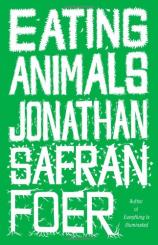Eating Animals
Review
Eating Animals
Jonathan Safran Foer is a novelist, not a journalist. He is often lauded (or derided) for his inventive verbal pyrotechnics, but there is nothing coy or cute about the title of this book. Becoming a father inspires him to explore his nascent vegetarianism, and he feels a parent’s responsibility to validate his or her eating habits in order to determine what is best for his or her child. With this in mind, he embarks on an enormous amount of research. EATING ANIMALS is not a novel, but if you are an open-minded carnivore, you may wish that some of what you learn was fictional.
Foer acknowledges that eating animals is a “slippery, frustrating, and resonant subject” that often provokes “defensiveness or aggression.” It forces us to ask huge philosophical questions involving the nature of suffering and our own human identity. Are we animals? Foer begins by pointing out the obvious: dogs are animals, and in our culture we don’t eat them. Why? Other cultures do and have. We wouldn’t even have to eat pets. “Three to four million dogs and cats are euthanized annually. This amounts to millions of pounds of meat now being thrown away every year.” So why don’t we simply eat those animals rather than expend energy and money to have those bodies rendered and fed to livestock, which we then eat?
In ways such as this, the book forces us to confront our own beliefs about what we choose to eat and why. It’s an uncomfortable ride, but saved from polemic by the inclusion of some opposing viewpoints. In a section called “Hiding/Seeking,” a retired farmer says, “Sure, you could say that people should just eat less meat, but I’ve got news for you: people don’t want to eat less meat... High-yield farming has allowed everyone to eat.”
I’ll go out on a limb here and say that I found reading this book strangely like reading a thriller. Foer has woven his material into short, powerful sections, and, true to his literary reputation, he distorts standard forms to make his points. It’s not a funny subject, but his deft language kept it compelling and, at times, humorous. During one secret nocturnal visit to a turkey farm with an animal activist, for example, Foer clutches his copy of the California penal code 597e, which states that it is lawful for any person to supply a confined animal with food and water. “I’m imagining some roused-from-REM-sleep-and-well-armed farmer coming upon I-know-the-difference-between-arugula-and-rugelach me scrutinizing the living conditions of his turkeys.” 99% of all the meat consumed in the United States is factory-raised. (In the Notes section at the back of the book, he cites the sources for facts such as these, and there is also an extensive index.) Even putting aside the treatment of the animals, the environmental impacts of factory-raised meat are enormous.
“Almost always, when I told someone I was writing a book about ‘eating animals,’ they assumed, even without knowing anything about my views, that it was a case for vegetarianism. It’s a telling assumption, one that implies not only that a thorough inquiry into animal agriculture would lead one away from eating meat, but that most people already know that to be the case.” Yet the book, he insists, is not meant to be “a straightforward case for vegetarianism.” In addition to illuminating the commonly hidden practices of factory farming, Foer reminds us how intricately what we eat is entwined with the stories we tell ourselves about ourselves.
Reviewed by Eileen Zimmerman Nicol on April 27, 2011
Eating Animals
- Publication Date: November 2, 2009
- Hardcover: 352 pages
- Publisher: Little, Brown and Company
- ISBN-10: 0316069906
- ISBN-13: 9780316069908





